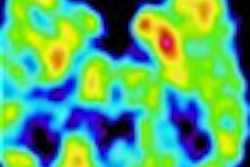American College of Radiology, Philadelphia, 2001
$250 for ACR member; $600 for non-members; $125 for members-in-training
This ACR Learning File on the chest is a near complete resource. Each topic is thoroughly discussed with text and images, providing every level of radiologist with ample repetition and variation on disease processes to solidify comprehension. Utilizing an improved interactive format, this product offers cased-based teaching at its finest.
Earlier text-based teaching files wrestled marrying accessibility with navigability. This software usually overburdened the user with information, poor presentation, and non-intuitive interface. These problems come to an end with this particular teaching file.
The case specific information comes in the standard ACR format with history, findings, diagnosis, and differentials covered for every subject. There also is a discussion of pathophysiology with a focus on unique radiographic characteristics to the disease process.
The images, primarily plain film, CT and occasionally high-resolution CT, are of superior quality even when subjected to magnification. Contrast and brightness on the images can be adjusted without losing resolution.
The categories cover most of chest radiology with a few exceptions. The first topic reviewed is normal anatomy on x-ray and CT. Unlike other similar products, this one rightly assumes that once is not enough: Multiple examples, with cross modality correlation are offered to hammer in comprehension. Normal variants are also included in this section.
With this helpful introduction, the user is then given the option to choose from multiple categories, such as the pathologies effecting adult and pediatric lung parenchyma, including congenital abnormalities, neoplasms, and infection, as well as diffuse and airway disease.
Mediastinal, chest wall soft tissues, and the diaphragmatic diseases are fully reviewed. The section of chest trauma is exceptional. The final categories cover the heart and great vessels with a few MRI examples. However, the plain film and CT patterns of disease, are thoroughly covered.
One of the deficiencies on this CD is not enough information on the ailments affecting the osseous structures of the chest. The editor does acknowledge that certain topics are not dealt with in this version, including lobar collapse, the post surgical/ ICU chest, and cardiac neoplasms. The next version currently under development is slated to include these areas.
Another serious flaw is the lack of a cardiac MRI section. With this modality growing in its utility, and finding its place on written and oral boards, hopefully this will also be a consideration in the next version.
Routine use of this Learning File will certainly make for a better chest radiologist, whether at the workstation, lightbox or on the examination hot seat.
By Dr. Daniel ReidmanAuntMinnie.com contributing writer
August 14, 2003
Dr. Reidman is a radiology resident at the Madigan Army Medical Center in Tacoma, WA.
The opinions or assertions contained herein are the private views of the author and are not to be construed as official or as reflecting theviews of the Department of Defense.
If you are interested in reviewing books, let us know at [email protected].
The opinions expressed in this review are those of the author, and do not necessarily reflect the views of AuntMinnie.com.
Copyright © 2003 AuntMinnie.com



















